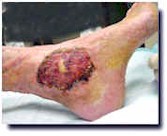

Warning:
This page includes graphic medical images that may be disturbing and better suited for medical professionals.
The physical therapist at the National Hansen's Disease Program plays an integral part in the pre- and post-operative treatment of patients requiring foot surgery.
Pre-operative therapy may be necessary to prepare a patient for surgery and may include such interventions as wound care, muscle strengthening or serial casting. Often, a posterior splint is fabricated by the physical therapist prior to surgery for use as a post-operative dressing that will immobilize the extremity.
Post-operative wound care and monitoring of the surgical site in the PT department facilitates early detection of complications or infection at the surgical site should they arise.
A surgical approach to healing the lower extremity may be considered if previously described conservative treatments are not producing optimal results. Several routine procedures are occasionally performed and designed to balance bony structures, improve biomechanics or enhance soft tissue for reduction of high pressures during functional ambulation.
Procedures for the foot may include the following:


